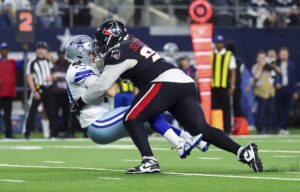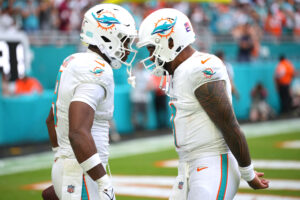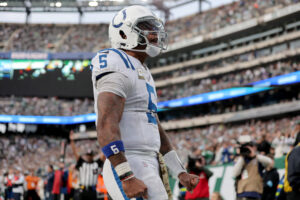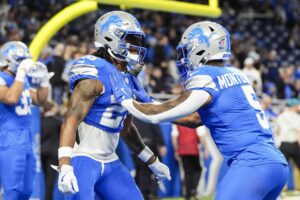Recently, ESPN’s 30 for 30 aired their documentary about the XFL, the professional football league that took the field in 2001 and was brought to us by Vince McMahon of World Wrestling Entertainment (WWE) and Dick Ebersol and NBC Sports. Directed by Charlie Ebersol, the son of Dick, it was a fascinating look at the league that only played one season, but is still talked about today.
Another Professional Football League Would Benefit Everyone
Even though the XFL lasted just one season and many were critical of the league as a whole, there were some positives that came from the league. The football might have been less than stellar, the presentation of the game wasn’t. The XFL utilized the “skycam”, a camera hanging above the football field by a cable. Although it had been experimented before the XFL, the XFL was the first to utilize it in regular season games. Not only did the XFL put to use the skycam, but they also put camera handlers on the field itself, giving fans watching from home a feel for what it is like for the players on the field. Both of these techniques are used by the NFL today and is part of their game production.
As documented in the special, at the beginning of the XFL, the action on the field wasn’t very inviting. But as the season went on, and the players got accustomed to each other and the play did improve. Although the league wasn’t created to be a developmental league for the NFL, it did just that. Two such players who benefited from the XFL was former NFL first round pick quarterback Tommy Maddox and linebacker Paris Lennon. Maddox used the XFL to get back into the NFL. He went on to play four seasons for the Pittsburgh Steelers and earned comeback player of the year in 2002 after suiting up for XFL. Along with Maddox, Lenon, who played for the Memphis Maniax in the XFL, went on to have a twelve year career in the NFL playing for seven different teams and played in one Super Bowl.
One of the most interesting parts in the 30 for 30 special came in the last scene, where McMahon and Ebersol were filmed having dinner together. In that scene, Ebersol asked McMahon if he would do it again, meaning start another football league. It didn’t take McMahon long to answer the question, it was a resounding yes. Which raises an interesting question, could another professional football league actually succeed in today’s professional football landscape? The answer might surprise football fans.
Learning From The Past
The XFL is one of many football leagues that ended up in the “Alternative Football League” graveyard. Joining the XFL in that graveyard are the American Football League, World Football League, the United States Football League, the World League of American Football which became NFL Europe, the United Football League, and recently the Fall Experiment Football League. There are other leagues that could be named that never even took the field, but the list is so long that it could go on and on.
The most successful football league that went up against the NFL was the American Football League (AFL). Founded in 1959 and taking the field in 1960, it lasted until 1970 when it eventually merged with the NFL. One of the biggest reasons the AFL succeeded was because of the owners that were a part of the AFL. People like Lamar Hunt (who was the driving force in starting the AFL) with the Dallas Texans/Kansas City Chiefs, Al Davis with the Oakland Raiders, Ralph Wilson, Jr. with the Buffalo Bills, Paul Brown with the Cincinnati Bengals, Joe Robbie with the Miami Dolphins, and Bud Adams with Houston Oilers (which later became the Tennessee Titans) were just some who were behind pushing the AFL in becoming a legitimate alternative to the all mighty NFL. The AFL helped make the NFL a better product, on and off the field.
The AFL was and still is the poster boy for new professional football leagues trying to start out. But one league that should represent what not to do to start a professional football league is the United States Football League (USFL). Founded in 1982, the USFL lasted until 1986. During the four years that the USFL existed, the league signed big named football players, players such as quarterbacks Doug Flutie, Jim Kelly, Steve Young, defensive lineman Reggie White, and running back Herschel Walker to big money deals. Throwing around money like it was going out of style and one owner, who would go on to become our President and who wanted to take on the NFL in court, became the demise of the league. Unlike the AFL, there would be no merger for the USFL and it would become the biggest name in the “Alternative Football League” graveyard.
Although the World League of American Football wasn’t a rival league to the NFL, it was actually backed by the NFL. It was played in the spring and was developed to become a feeder league for the NFL. With seven teams based in North America and three based in Europe, it took the field in 1991. That version lasted until 1993, the league took a year hiatus and re-started back up in 1995 with just six teams, all based in Europe. The reasoning for this was due to the larger attendance that European teams had when the league first started. In 1998, the league would be rebranded NFL Europe (NFLE). The league would run until 2007 when the NFL decided to pull the plug because of the high operating costs with playing all of its games overseas.
The Development of Players
Many NFL head coaches, NCAA head coaches, and players got their start in NFL Europe. The biggest names to come out of NFLE were former Carolina Panthers starting quarterback Jake Delhomme, current Indianapolis Colts kicker Adam Vinatieri, and recently NFL Hall of Fame inducted quarterback Kurt Warner. Although the league lost millions for NFL owners, it did help improve the play of developing players who eventually moved on to the NFL.
Looking back at WLAF/NFL Europe, it appears the decision to move the league overseas, which at the time seemed like the right thing to do because of the higher attendance, turned out to be the wrong decision. The costs of operating a professional football league overseas became too much for the owners of the NFL. With losing money every season, the NFL owners felt they needed to pull the plug on the league. However, if the owners would have stayed stateside, many believe the league would still be playing today.
The argument for many is that the NFL already has a developmental league, claiming that the NCAA is just that and doesn’t cost the NFL a dime. But the college game has changed. College football lacks solid defenses and the offenses are predominantly spread offenses, looking nothing close like what NFL teams run today. Without a developmental league to help players, especially quarterbacks and defensive players, the NFL has hurt the product on the field, something that might not have happened if they would have kept the WLAF.
Not All Competition Is A Bad Thing
Coke wouldn’t be Coke if it didn’t have Pepsi to compete against. That is the saying that most old business people say when it comes to competition. Since the USFL folded in the 1980s, the NFL hasn’t had a true competitor. It is true, without the competition, the NFL has become a multi-billion dollar industry and has made NFL owners a lot of money. It has also entertained millions of fans throughout the world. But still, it could be argued that the people behind the NFL and its owners, has not only taken its fans for granted, but the actual game itself. When it comes to the development of front office personnel, coaches, players, and referees, the NFL hasn’t done all it can to improve the game of professional football. Sure, they have tried to make every dime they possibly can from the game, but they haven’t put in the effort to improve the game and give fans what they are paying top dollar to watch. Just like what Mark Cuban, who owns the NBA’s Dallas Mavericks, once said about the NFL and its owners, “pigs get fat, hogs get slaughtered”, meaning the NFL and its owners are trying to get every dime they can from their fans, but not invest the money necessary to make sure the play on the field is the best it can be and stays that way.
One giant leap in improving the game would be for the NFL to create a true minor league system. Creating a developmental league, or some might call a “D-League”, like Major League Baseball and most recently the NBA have created, would help improve the NFL. It would give players, coaches, potential NFL front office personnel, and referees in-game experience that young players are in dire need of. For defensive players and quarterbacks that aren’t used to the NFL game, a developmental league could give time to develop their talents and down the road help an NFL franchise. It could also help the NFL experiment with new rule changes, using new rules in their “D-League” before putting them in place in the NFL.
A D-League would also be a benefit in regards to network television deals. With so many sports networks now on cable, like CBS Sports, NBC Sports, ESPN, and Fox Sports 1 to name a few, they are constantly looking for content to put on the air. The NFL also owns its own network, which would seem to be a perfect fit to air games for a developmental league. The creation of another league by the NFL seems like a win win situation.
Although NFL head of operations Troy Vincent has said that his department is ready to recommend a developmental league to the owners, it isn’t a slam dunk it would be approved by the NFL owners. The league and especially the owners could still be hung up by the money they lost with NFL Europe which would make it tough for approval. Even if the NFL isn’t the one to create another league, they could still benefit by the creation of one from an outside entity.
Opportunity Is There For The Taking
With the NFL possibly hesitant to invest in another league, there is an opportunity for an outside presence to do so. Even without being the money to back another league, the NFL could benefit from another league, allowing it to develop talent for the NFL and growing the game.
The XFL might not have worked out like Vince McMahon and NBC Sports had hoped, but there is something to build on. Whomever decides to give another professional football league a chance, it could learn from what the XFL did or in some cases, didn’t do. A new league will need someone like McMahon, minus some of his over-the-top brashness. For sure, a new league will need the bankroll to succeed, if not, the league will fail for sure.
There are certain things a new league will need to look for and to do to be successful. Although football fans are used to football being played in the fall, the chances of another league succeeding in the fall is nearly impossible. The United Football League (UFL) tried that from 2009-2012 and failed, folding in 2012 with former players and coaches suing the league for lack of payments. Going head-to-head against the NFL is a one way ticket to failure, which makes playing in the spring the only option.
Like the XFL, the UFL did do one thing right. For the most part, the UFL concentrated on markets that didn’t have professional football. The UFL had franchises in Hartford CT, Las Vegas, NV, Omaha, NE, Sacramento, CA, and Virginia Beach, VA. A new league would benefit by establishing their own identity, so putting franchises in cities that don’t have a pro football team would be the first proper step. By doing so, it would also benefit the NFL, with expanding the landscape of football in new cities.
As discussed earlier, if the NFL were to start a developmental league, there is a market to air games on the ever expanding market of sports only networks. It wouldn’t be out of the realm for the NFL, who owns its own network, to air these games as well. If a new league could forge a relationship, of some kind, with the NFL, their games could be aired on their network. It wouldn’t be the first time the NFL has done this. In the past, the NFL Network has aired Canadian Football League (CFL) and Arena Football League games. There are possibilities for a new professional football league to land a television contract.
Not only are there places for games to be aired, but there are also venues to play games. Sticking with playing games in cities that currently don’t have professional football franchises, there are currently five cities that have Major League Soccer (MLS) franchises that have soccer or predominantly soccer only stadiums and that don’t have an NFL franchise. Although MLS might first frown upon sharing their stadium with a professional football franchise, the extra revenue that could be had by having a tenant for their stadiums, might be too much to look past.
Who Will Step Up?
It won’t be an easy task that is illustrated by the many leagues that have failed to do so, but there is an opportunity for another professional football league to succeed. If the right person or people get behind the league and they learn from past mistakes, there is an opportunity not only to succeed on the field, but also for somebody to make money. The biggest task might be finding the right person to lead this charge.






